
Mentha is a genus of plants in the family Lamiaceae. The exact distinction between species is unclear; it is estimated that 13 to 24 species exist. Hybridization occurs naturally where some species' ranges overlap. Many hybrids and cultivars are known.

Spearmint, also known as garden mint, common mint, lamb mint and mackerel mint, is a species of mint, Mentha spicata (, native to Europe and southern temperate Asia, extending from Ireland in the west to southern China in the east. It is naturalized in many other temperate parts of the world, including northern and southern Africa, North America, and South America. It is used as a flavouring in food and herbal teas. The aromatic oil, called oil of spearmint, is also used as a flavoring and sometimes as a scent.

Mentha longifolia is a species in the genus Mentha (mint) native to Europe excluding Britain and Ireland, western and central Asia, and northern and southern Africa.

Actaea spicata, the baneberry or herb Christopher, is a species of flowering plant in the genus Actaea, native from Europe to western Siberia and northern Iran. It is often found on limestone edges and in deciduous woodland; key factors are shade, low competition, and a cool, protected root run.
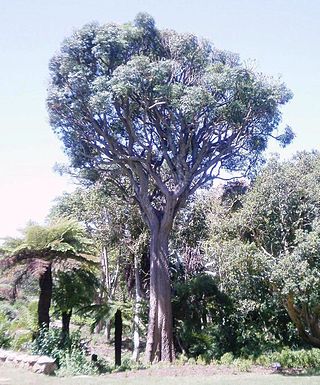
Cussonia spicata, known as spiked cabbage tree, lowveld cabbage tree or common cabbage tree, is a tree in the family Araliaceae, which is native to the moister regions of Sub-Saharan Africa. It is cultivated as a garden plant in areas without extreme degrees of frost. It is one of the favorite foods of wild elephants.

Veronica spicata is a species of flowering plant in the family Plantaginaceae. It is 1–3 feet (0.30–0.91 m) tall and bears 1 foot long spikes with blue, pink, purple and white flowers.
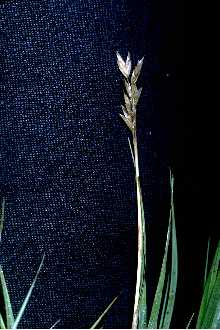
Distichlis spicata is a species of grass known by several common names, including seashore saltgrass, inland saltgrass, and desert saltgrass. This grass is native to the Americas, where it is widespread. It can be found on other continents as well, where it is naturalized. It is extremely salt tolerant.
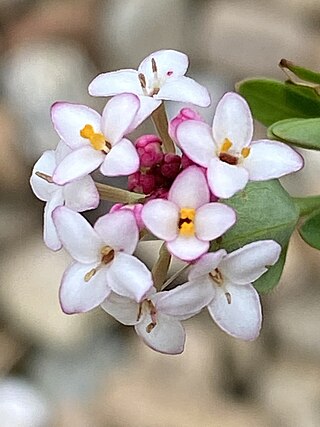
Pimelea spicata, commonly known as the spiked rice flower, is a flowering plant in the family Thymelaeaceae and is endemic to New South Wales. It is a slender plant with white flowers and elliptic leaves.

Liatris spicata, the dense blazing star, prairie feather or gayfeather, is a herbaceous perennial flowering plant in the family Asteraceae. It is native to eastern North America where it grows in moist prairies and sedge meadows.

Pseudoroegneria spicata is a species of grass known by the common name bluebunch wheatgrass. This native western North American perennial bunchgrass is also known by the scientific synonyms Elymus spicatus and Agropyron spicatum. The grass can be found in the United States, Canada, and Mexico from Alaska and Yukon south as far as Sonora and Nuevo León.
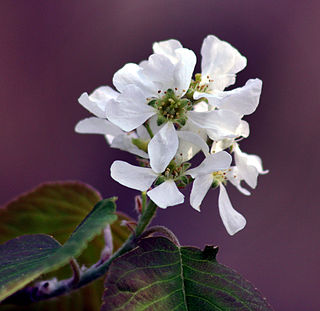
Amelanchier × spicata, also referred to as the low juneberry, thicket shadbush, dwarf serviceberry, or low serviceberry, is a hybrid of Amelanchier alnifolia × Amelanchier humilis. that has edible fruit, which are really pomes. They can be eaten raw or cooked. Amelanchier × spicata has clusters of small white flowers that bloom in spring.

Carex spicata is a species of sedge in the genus Carex.
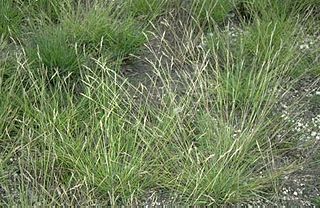
Danthonia spicata is a species of grass known by the common name poverty oatgrass, or simply poverty grass. It is native to North America, where it is widespread and common in many areas. The species is distributed across much of Canada and the United States, and its distribution extends into northern Mexico.
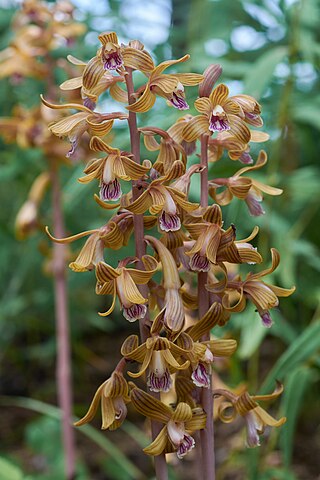
Hexalectris spicata, the spiked crested coralroot, is a terrestrial, myco-heterotrophic orchid lacking chlorophyll and subsisting entirely on nutrients obtained from mycorrhizal fungi in the soil. It is native to Arizona, New Mexico, Texas and Coahuila. It is closely related to H. arizonica and the two are sometimes considered varieties of the same species. Hexalectris spicata is endemic to the southern half of the United States from Arizona east to Florida and north to Maryland and the Ohio Valley.

Catoferia is a small genus of plants in the family Lamiaceae composed of only four different species. First described in full by George Bentham in 1876, said species are native to southern Mexico, Central America, Colombia and Peru. Amongst all four species, only Catoferia chiapensis are known to grow across a wide area, their growth recorded in southern Mexico, Guatemala, Peru and Belize. Growth of the other three variants is believed to be limited to Southern Mexico. The beginning of the genus Catoferia is thought trace back to the Cretaceous era, making it around 55 to 65 million years old.
Proboscidea spicata, the New Mexico unicorn-plant, is a herbaceous, flowering plant.

Indigofera spicata, the creeping indigo or trailing indigo, is a species of flowering plant in the family Fabaceae. It is native to Sub‑Saharan Africa, Madagascar, Mauritius, Réunion, and Yemen, and has been introduced to the southeastern United States, various Caribbean islands, Brazil and other locations in Latin America, various Pacific islands, and New South Wales and Queensland in Australia. It was considered to be a promising forage plant, and then shown to be toxic to nearly all livestock, but it is possible that the experiments were conducted on the similar Indigofera hendecaphylla, leading to some confusion.
Catoferia chiapensis is a species of flowering plant in the family Lamiaceae. Its native range is from Mexico to Honduras.















